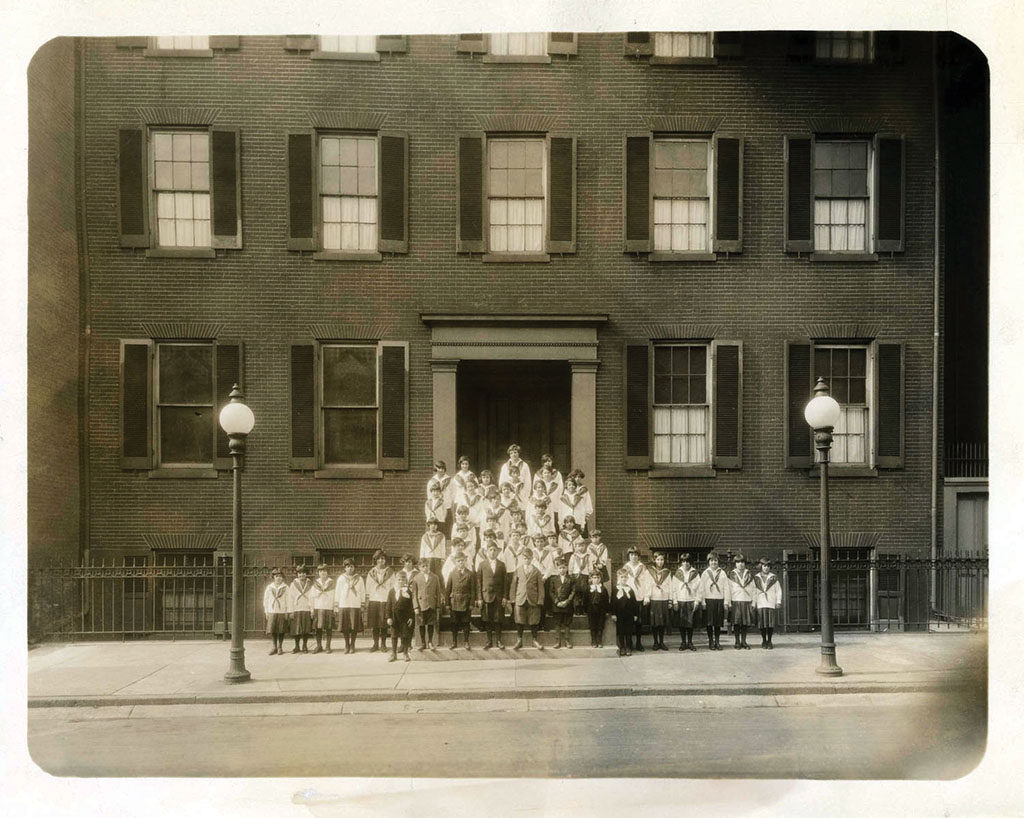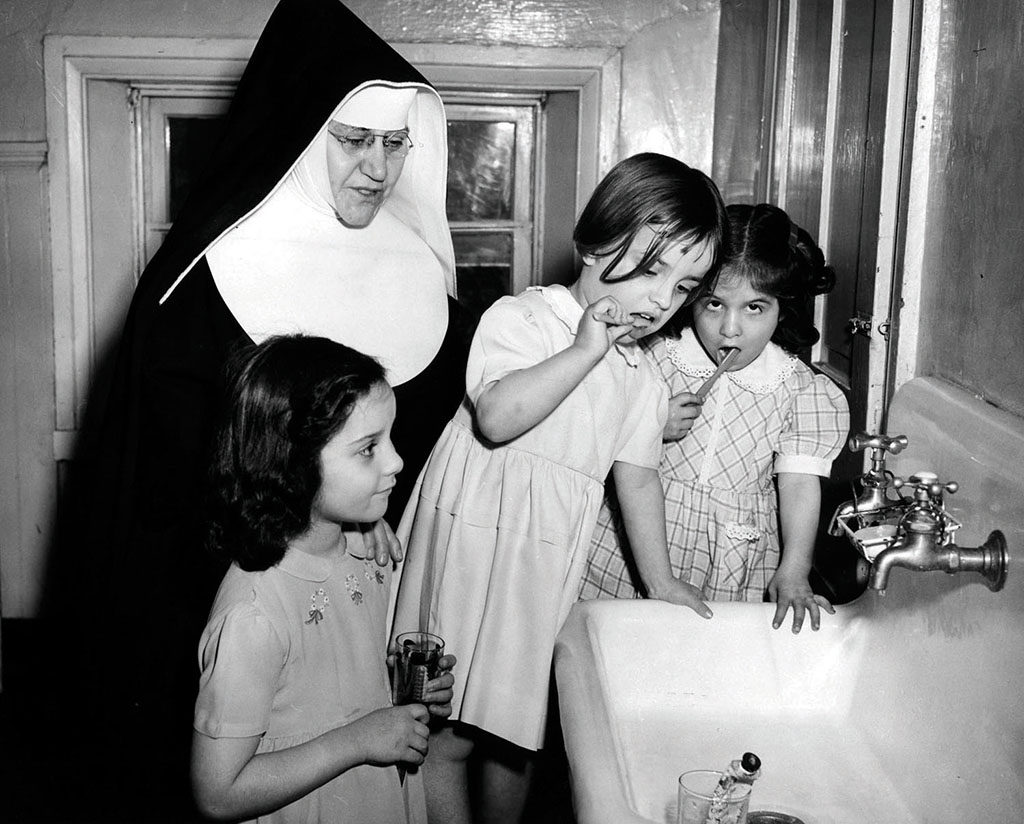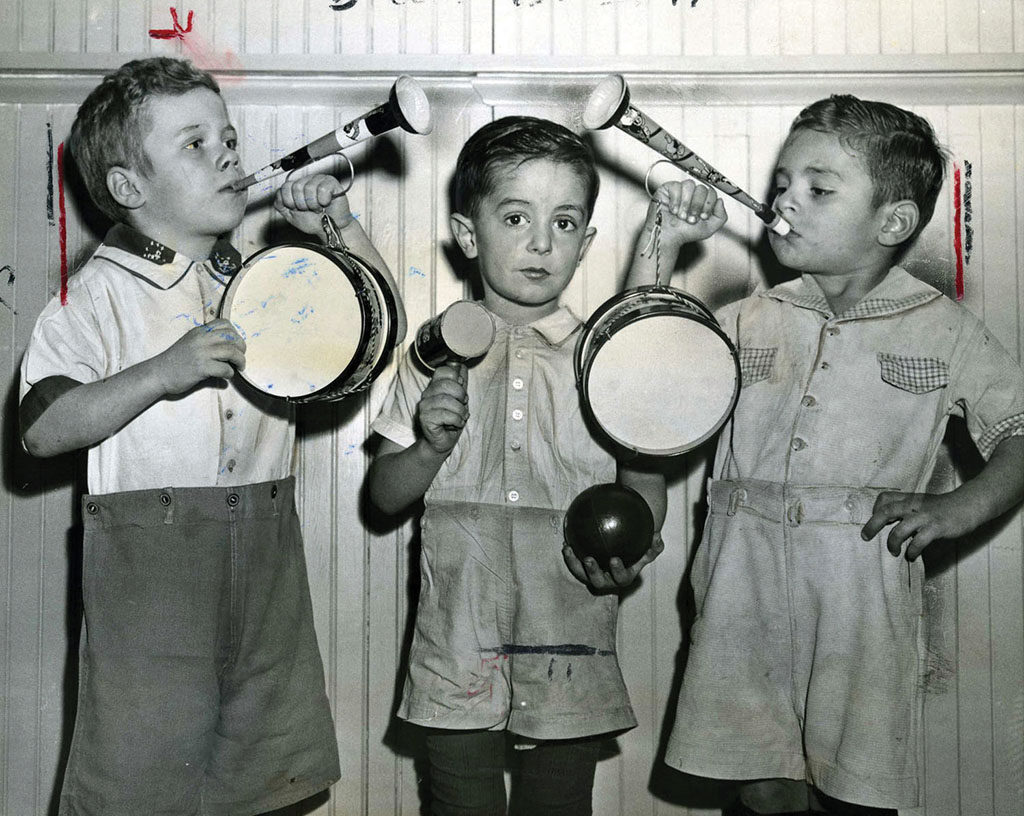On the freshly ironed tablecloth in Caroline Lee Ringus’ home in Middle River, are a plate of artfully arranged Pepperidge Farm cookies and a lone, worn manila envelope containing seven, maybe eight photographs of varying sizes. These are the only record of Ringus’ childhood growing up at St. Leo’s Italian Orphanage in Baltimore’s Little Italy.
Caroline shakes them out and picks them up, waving them in the direction of the kitchen.
“How would you like some coffee?” she asks, smiling.
Less than five minutes has passed, and already it’s clear this is not going to be a story about living the hard-knock life in a Baltimore Catholic orphanage supervised by the joyless religious.
“Have a cookie,” Caroline says.
Caroline rattles off the names and ages of her siblings, and immediately something seems odd, out-of-sync. Of course. Caroline gives their ages in the year 1951. The year she and her six siblings were removed from the streets of Baltimore and divided up: five at St. Leo’s — which housed school-aged orphans — and two at St. Vincent’s, which took in toddlers and infants.
One by one, Caroline picks up the photos: Here she is standing next to her older sister, Betty (Elizabeth Josephine), who ran away from her foster home at age 16 and disappeared for the next 18 years. In this one, Betty is lanky and gorgeous, with a lush head of caramel hair, a knockout figure and unhappy eyes that have seen too much for a young teenager.
Here is her sister Lee (Leona Dolores), 10, who was like a mother to Caroline — to all of them once Betty left. Blonde, blue-eyed and with a hairline scar from her repaired cleft lip and palate, she looks nothing like Betty.
Here is Peter Alexander at around 9, his expression as unfocused as this shot — Caroline says he was always considered “slow.” In fact, he used to call her “Carline,” and she assumed his mispronunciation was due to his disability. But when she had to locate her original birth certificate for a passport in 2007, she discovered her name was spelled exactly as he pronounced it all those years.
In a photo with his arms folded, shoulders slightly hunched, the classic, annoyed expression of any boy interrupted to take any photo, is David Joseph, 5. His ears stick out like Alfalfa’s from “Our Gang,” a feature that led Caroline to believe he’s in the foreground of the only photo from the Archdiocese of Baltimore archives of the wards in study hall. But there’s no way to know for sure, because this was a publicity photo, not a family treasure, and no one wrote the names of the children on the back.
Finally, shyly, Caroline reveals a photo of Caroline Lee Ringus. She is 7 years old, blonde curls framing an angelic heart-shaped face, the hint of an upturn at one side of her rosebud mouth. She is wearing the bathing suit her mother brought for her one time during a visit. It’s a spring green that accents her fair palette. Funny, green has always been her favorite color.
 St. Leo’s Italian Orphanage was the brainchild of the Rev. Joseph M. Riedl, pastor of St. Leo the Great Roman Catholic Church on the corner of Exeter and Stiles streets in Baltimore. Concerned about his parish’s high number of orphaned children as well as those struggling in single-parent homes, he presented his plan to Cardinal Gibbons in the fall of 1913. He would use the building at 112 North Front St., to the south of St. Vincent de Paul Church and across from St. Vincent’s School, to house these children, keeping brothers and sisters together whenever possible — a concept unheard of at the time.
St. Leo’s Italian Orphanage was the brainchild of the Rev. Joseph M. Riedl, pastor of St. Leo the Great Roman Catholic Church on the corner of Exeter and Stiles streets in Baltimore. Concerned about his parish’s high number of orphaned children as well as those struggling in single-parent homes, he presented his plan to Cardinal Gibbons in the fall of 1913. He would use the building at 112 North Front St., to the south of St. Vincent de Paul Church and across from St. Vincent’s School, to house these children, keeping brothers and sisters together whenever possible — a concept unheard of at the time.
The building was ideal, as it was originally constructed and managed under the jurisdiction of St. Vincent de Paul Church as an orphanage for boys. Reidl simply championed the repurposing of it. An August 1913 Baltimore Sun article states Cardinal Gibbons “has assigned the Italians to the building” and that he “readily approved the enterprise” brought to him by Riedl and his committee. St. Leo’s Italian Orphan Asylum was incorporated by 1915 and could feed, clothe, house and educate a ward for 13 cents a day.
One of three church buildings lining North Front Street, the orphanage sat to the south of the stark, neoclassical St. Vincent de Paul Church, arguably the centerpiece of the parish complex. A simple rectory flanked the church to the north. St. Vincent de Paul Church, recessed and elevated from the street, featured a soaring bell tower with a simple cross at its apex. In contrast, the brick orphanage was constructed closer to the street on a raised basement and ascended four stories high, its walls exceeding those of the church. The only nod to the Greek Revival styling was the orphanage’s entryway, set back and defined by pilasters.
A 1940 engineering report and map of parish property offers the best indication of the orphanage’s interior layout: A basement for storage and the boiler room; a first floor with a kitchen, dining rooms and storage rooms; offices, a chapel and reception rooms on the second floor; an infirmary and living quarters for the Pallottine Sisters who staffed the orphanage up on the third floor; and an upper floor for children’s dormitories. And all of this in a footprint measuring just 2,350 square feet, although an annex added some space.
Caroline recalls nothing about the particular day she and her four siblings entered St. Leo’s. Nor does she remember attending school before living there.
“We walked the streets,” she says. “We had no shoes, no coat, just an undershirt and drawers.” Her face brightens when she recalls “that nice Italian lady” who had nine or 10 children herself but used to feed Caroline and her brothers and sisters with whatever she could spare. Caroline once wolfed down an entire loaf of bread at her table; she wishes she could remember that woman’s name now.
Caroline’s mother had been a bartender and was never at home. Her father left his family’s work in the Pennsylvania coal mines because he couldn’t breathe and came to Maryland to look for a job. But the post-World War II boom had not yet occurred. Caroline knows her father joined the Army for a short time to try and support his family, but still had a hard time making ends meet— what mattered was that he visited every Sunday, unless he was sick or had a job, until the day he died.
 In the seven years she was at St. Leo’s, her mother came to visit “maybe four times.” Her first visit was six months after Caroline and her four siblings were admitted. That was the orphanage’s rule.
In the seven years she was at St. Leo’s, her mother came to visit “maybe four times.” Her first visit was six months after Caroline and her four siblings were admitted. That was the orphanage’s rule.
A nun known as Sister Chiro (pronounced “Cheero”) was in charge; the irony of her name is not lost on Caroline today. She lined up the five of them for the visit. The only ones missing were Maryann Ringus, 3, and Nancy Marie Ringus, 18 months, housed in the babies’ program at St. Vincent’s.
“Who are you?” her mother asked Caroline when she reached her place in line.
Caroline stammered that she was her daughter, but her mother had continued walking. “I will never forget the pain of that moment,” Caroline says. Perhaps her mother didn’t recognize her, she admits. In six months, Caroline had transformed from a frail, paper-doll of a girl to a bony, somewhat Shirley-Templesque beauty. Or maybe her mother just didn’t want to face the obvious: This child wrest from her haphazard parenting was thriving in an orphanage.
Caroline doesn’t dwell, though. She moves on to talk about the daily routine at St. Leo’s, where she slept on the top floor next to a window with a stunning view of the Shot Tower. The view was never so magical as on Spaghetti Dinner night, the annual orphanage fundraiser in Little Italy.
Every child at St. Leo’s was assigned a single bed, a metal storage cabinet and a chair. The dorm had five or six beds across, and a nun slept in the corner of the room, with one of those hospital-type curtains that provides a semicircle of privacy.
The day started at 6 a.m.; the older children took care of the younger ones, helping them get dressed for the day and then hurrying themselves downstairs to go to chapel and then set up and serve breakfast by 7:30. All the children ate together in a large hall, and then cleaned it all up and walked across the street at 8:30 to St. Vincent’s Catholic School, which they attended from 9 a.m. until 3 p.m.
Caroline hated school. A naturally inquisitive child, she didn’t know she had dyslexia, so she simply believed what she was told, that she was terrible at learning. She would stay late every day to struggle to learn her lessons, and then come back to the orphanage, attempt to do homework and catch up on chores. At 5 p.m. all of the children would walk to St.Vincent’s to recite the Holy Rosary on their knees.
Dinner would be between 6 and 7, followed by clearing and cleaning the dishes, and helping the little ones get ready for bed. The older girls could watch some TV while ironing the linens. Lights out was promptly at 9.
Repeat, Monday through Friday. Add obligatory rosaries recited by the orphans en masse at the intersection of public relations and spirituality — the mandatory procession of orphans at the funeral services of every St. Leo’s Orphanage benefactor, sometimes at least two patrons passed per month.
And if that weren’t enough time on one’s knees, the girls were tasked with scrubbing down the orphanage staircase every weekend. A couple of years ago, a new Giant Food store opened in Caroline’s neighborhood and every time she shopped there, she felt sick to her stomach. One day when she took a deep breath in to steady herself before shopping, she realized that Giant Food used the same cleaning fluid on their floors that she had sloshed in a bucket up and down the orphanage steps. That was the source of her nausea.
There were plenty of happy memories, though: “Sister Isabella did the cooking. She was happy-go-lucky, and kind of chubby. She would teach you anything.” Sister Isabella set little Caroline on an upper shelf in the kitchen, where the vats of freeze-dried prunes were kept. She pretended not to notice, letting little Caroline eat as many prunes as she wanted.
“To this day, I just love prunes,” Caroline says.
Christmas at the orphanage was one of the best times, especially the annual Christmas party thrown by the police station across the street, when all the St. Leo’s kids got to sit on Santa’s lap.
When it was Caroline’s turn, Santa announced that he had a special gift if she could sing “Jolly Old St. Nicholas.” Caroline sang that song at the top of her lungs. People stopped their chatter and fell silent. The donation box swelled and Caroline got the prize, a Shirley Temple doll, dressed in a red polka-dot party dress, with her signature perfect curls.
She doesn’t remember exactly what happened, what sort of altercation ensued when they got back to the orphanage, but Sister Chiro took the Shirley Temple doll away. Caroline never got her back. Decades later, her sister Lee had that exact Shirley Temple doll made for Caroline and surprised her with it for her 50th birthday.
When St. Leo’s closed in the 1950s, the siblings were broken up and placed in different homes. Caroline and Lee were sent to live with a family. When that didn’t work out, Lee was sent to live with a single woman who worked for Western Union, who persuaded her sister, a beautician with three children of her own, to take in Caroline and David, and later on, Nancy. But the sister was a drinker and Caroline says the Ringus children were “kind of her slaves,” washing all the towels from her beauty shop, cleaning the floors and cooking the dinner.
She finished high school and fell in love and got married, and worked for couple of years at Johns Hopkins Hospital. She stayed home to raise her two boys until her husband left her abruptly in 1982. They divorced a year later, but Caroline doesn’t dwell on that, either. She got a driver’s license and began working in jobs that allowed her to make her sons a priority, first the Baltimore City Schools and the Department of Parks and Recreation and then later Port City Press, from which she retired after 27 years.
She read no parenting books. She had no real role models. She just loved her children in a fierce and loyal and unselfish way. It’s something she somehow learned from those years growing up at St. Leo’s Italian Orphanage.
“I hated it at the time,” Caroline says. “But I’ve come to realize I would probably have been dead if I hadn’t been there.”






I just read this article, about six years after it was published. I was in St Leo’s Orphanage in the mid 1950’s and wish I could reconnect with Caroline to swap stories. I vividly remember Sister Chiro and especially, Sister Isabella. I remember that Sr Chiro was the disciplinarian, but remember nothing sinister about her. Caroline is right about Sr Isabella; she always treated me with love, but would pinch me in the cheeks whenever she saw me, “Francesca, come here!”–I have told my wife and kids this story endlessly, but I was maybe four years old when I entered the orphanage and all kids who didn’t;t go to school had to take a nap. Sr Isabella would have homemade lady fingers, warm from the oven, and ice cream ready for us when we were awaken from our naps! Who does that???–So you’ll never hear me talk contrary about nuns!
Peter was my father. Heard many many stories. Some hood some not do good. Caroline my aunt Loved reading this article my father and siblings had a hard story to live.